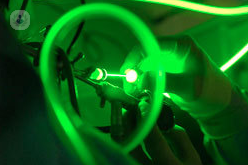Green an effective technique for laser treatment of the prostate,
Written by:The laser vaporization of prostate Green XPS (GreenLight) is a safe procedure with minimal bleeding, few complications and immediate results.
The green laser is a technique with multiple applications, and one of them is precisely performing a vaporization of the prostate, ie, surgery responsible for removing adenoma (benign prostate tissue) that would hamper adequate urination in male posing this problem.
The benefits of green laser
"It is true that all roads lead to Rome but it is best to go in a private and comfortable flight not drive". What does this mean?
Well, it's very easy, all urologists know that a well-practiced operation will leave the patient urinating prostate well and free of obstruction presented by blockage of adenoma. And the best way to practice is by the green laser.
The great advantage of green laser is that it offers the same results as conventional RTU but with very few complications. It is indicated in all patients with adenoma or benign prostatic hyperplasia well documented, with poor quality of life resulting from a lack of effectiveness of the prescribed medication or adverse effects of it accompanied by an enlarged prostate and weak urinary stream with little force.
How a conventional RTU (transurethral prostate resención) is performed
The results are very good in one way or another but the classical RTU prostate is more uncomfortable for the patient, can cause bleeding and an increased number of complications.
One of the highlights is bleeding during the RTU that agrees to use during this procedure a number of fluids under pressure as glycine 5% or serum washing serves to remove blood that impairs vision during surgery and slows to Sometimes the art.
These fluids are sometimes absorbed through the same venous bleeding vessels, causing, in some patients, analytical and volume overload alterations in the heart.
Likewise both the heat generated by the electric scalpel conventional TURP are responsible for injuries to the urethra by producing heat injury by diathermy and therefore stenosis (strictures) in the urethra months later after surgery, which can cause a serious disorder and may even require new surgeries to address them.
In addition to surgery, if bleeding is high, injuries due to poor visualization sphincter may occur since it is in intimate contact with the prostate, which would cause urinary incontinence, with continuous urine leakage after surgery.
Why choose the green laser?
Using green laser (Green Light XPS):
- No loss of blood.
- With classical RTU the tube is removed at 4-5 days which lengthens hospital stay, with green laser within 12-24 hours.
- The relief of obstructive symptoms is immediately after the technical.
- The results are maintained long-term and do not need to make further surgeries on the prostate.
- Back to normal life within 2-3 days
- No passage of electric current or heat generation except at the tip of the laser fiber (which does not penetrate more than 1-2 millimeters), so there is no nerve damage and impotence occurs (impotence is less than 1%)
- The absence of heat and electricity, along with smaller diameter instruments used for laser avoids the dreaded s uretrale stenosis (stricture of the urethra) that might weeks after TUR conventional prostate occur.
Risks green laser
The risks are minimal.
- 30-40% of the operated patients referred retro-ejaculation or retrograde ejaculation. With classical or conventional RTU incidence is 80-90%. Less than 1% of patients said erection problems.
- In 10% of patients irritative syndrome (increased urinary frequency, burning and urgency) that disappears after a few days postoperatively precise treatment occurs.
- 5% of patients refers to blood in the rust with urination but this does not require any action by the urologist and disappears in a few days.
What is the postoperative?
The preparation is very simple. The patient can enter fasting on the day of surgery and preoperative done, then being subjected to the intervention usually lasts 1 to 2 hours. When the procedure a catheter gauge 20-22 ch (three-way) who retires in about 12-24 hours after surgery so that patients can be at home after 24 hours of operation is left after checking urinating spontaneously without problems.



